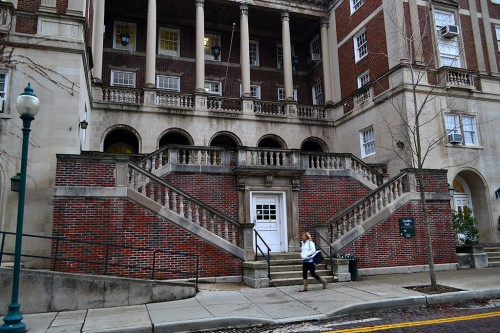 Today is May 4. I’m going to be disappointed if I don’t hear from my old chief photographer, John J. Lopinot, today. He always sends me a message on May 4 that says, simply, “Never forget.” He’s referring to the killing of four students at Kent State on that date in 1970.
Today is May 4. I’m going to be disappointed if I don’t hear from my old chief photographer, John J. Lopinot, today. He always sends me a message on May 4 that says, simply, “Never forget.” He’s referring to the killing of four students at Kent State on that date in 1970.
I’ve published pictures of the protest era over the years and am working on putting together a photo exhibit for May 2014.
While I was killing time before speaking at a photo exhibit of my Martin Lutheran King National Day of Mourning pictures, I wandered around the Ohio University’s Main Green, feeling a lot like the old geezer in Catcher in the Rye who went back to his old school to see if his initials were still carved in a bathroom stall.
When I stood in front of Lindley Hall, a dorm on Court Street, I had a flashback to 1970.
May 15, 1970
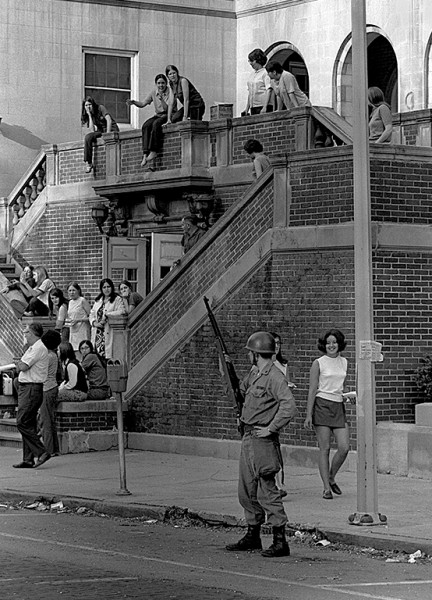 After two nights of tear gas and rioting, Ohio University closed and students scrambled to get home.
After two nights of tear gas and rioting, Ohio University closed and students scrambled to get home.
Anxious parents descend on town
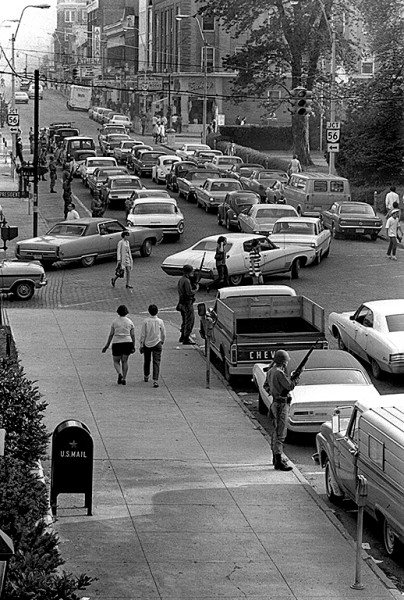 Frantic parents clogged all the streets in town trying to pick up their students. Every breeze would cause tear gas powder to rain down from the trees, causing red eyes for blocks. National guardsmen, some with bayonets affixed were spaced all over the downtown and campus area.
Frantic parents clogged all the streets in town trying to pick up their students. Every breeze would cause tear gas powder to rain down from the trees, causing red eyes for blocks. National guardsmen, some with bayonets affixed were spaced all over the downtown and campus area.
Incredible wave of emotion
I climbed to the landing where I had taken the photo above and felt an incredible rush of emotion. I was transported back to that time. I can’t explain why that particular location triggered the feeling.
Did something happen here?
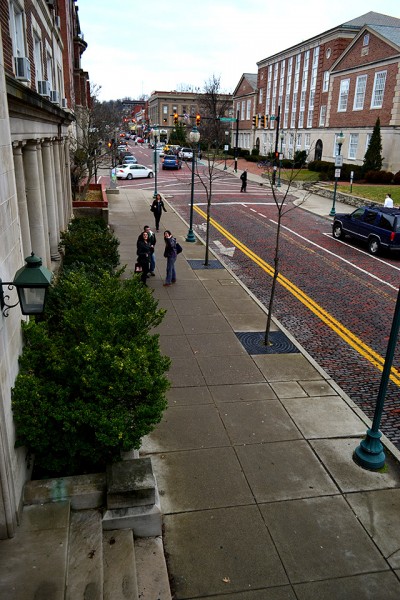 While I was coping with that and composing this photo, two coeds ran squealing down the street and jumped on the back of a male student. There was much high-fiving and quite a reunion going on. Finally one of them saw me with a camera and gave me a friendly wave. I returned the wave and walked down to them.
While I was coping with that and composing this photo, two coeds ran squealing down the street and jumped on the back of a male student. There was much high-fiving and quite a reunion going on. Finally one of them saw me with a camera and gave me a friendly wave. I returned the wave and walked down to them.
“You know, the last time I stood on that landing and took a picture looking down Court Street it was May 15, 1970. Tear gas was wafting through the air and there was a National Guardsman with a rifle spaced about every 25 feet.”
“Really? Something happened here?” one of them asked, giving me a “is this old geezer harmless?” look..
If I don’t get the message from John, I guess it’s a sign that we really have forgotten.
My initials were gone
I didn’t carve my initials on the wall of a bathroom stall, but it was a tradition for the photo editor of The OU Post to put his (they had all been male up to that point) initials on the darkroom door. The white arrow, top left, points to my “KLS 68“. I was killing time waiting for that night’s demonstration or other madness to start when this picture was taken in 1970.
Baker Center, where The Post lived, is being remodeled and the basement where my initials were scrawled has been gutted no telling how many times over the years. That’s the way it goes.

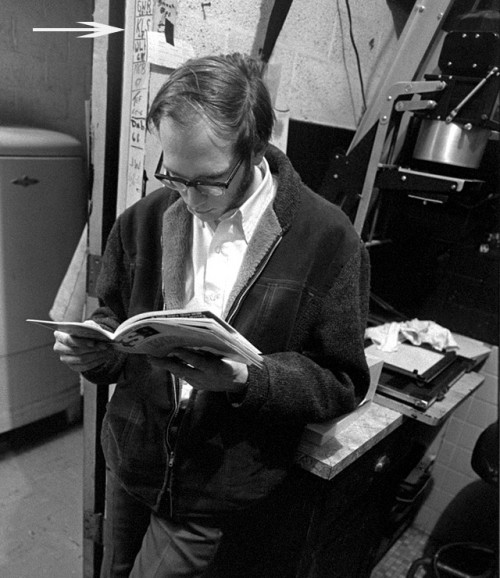
Kent State still holds annual commemoration events on May 4. But on the national level, yes, the tragedy has largely been forgotten. I think it’s partly because 43 years have passed, and partly due to the way our world has changed. In 1970, shootings and bombings in small-town America were rare. Today, there are bomb scares and ‘gunman on campus’ warnings nearly every day. One can only hope that the lessons learned from Kent State have not been lost, even if the event itself is fading from memory.
Having been a student and then a member of Ohio National Guard, I cannot stress how much pressure was put upon us who served. We never wanted to be there. We were ordered to be there. And we did our duty.
It’s not forgotten with baby boomers, but in the bigger picture, few will note the date. Whole different atmosphere and mood shift. Our focus on enemies is scattered today here and abroad – it’s so not clear. Though I see the same kind of government mistrust growing louder by the minute there’s not the social disconnect between generations as before – or it’s lackadaisical. All those (whatever) Liberation and (whatever) Pride and anti-war marches are either now multigenerational or not happening – and not centered on college campuses. A growing voice is questioning college educations, as well. My take on it, anyway.
If there was still a draft, you would see protests like the ’60s and we wouldn’t have been in 10-year (and counting) wars. It’s easier to “support the troops” by putting magnets on your car than it is to BE a troop.
Having a volunteer army may be more efficient and politically expedient that a draft, but it takes a lot of skin (literally) out of the game.
How sad that a student at Kent State would not know of the tragedy there. If we do not know our history, how do we have guidance for our future? Otherwise we make the same mistakes.
In fairness to the student, I was at Ohio University in Athens, Ohio, not Kent State. From her tone of incredulity, though, I’m not sure it would have made much difference.
Has it been that long really since that horrific day? I still have the images in my mind as well. thanks for posting this!
I hope it is still considered rare when U.S troops shoot at American citizens on a college campus and kill them. I was in Madison, WI, at the time and the protests were huge, lots of teargas, and National Guard, but no one was shot and killed.
I have Earl Morris’ DVD “The Fog of War” about Robert McNamara’s remembrances, that I felt was his way of leaving a footprint for future leaders. His courage was remarkable. He admitted the errors of his thinking and it was in a way an apology to our classmates who gave their lives in Vietnam. Time and the fall of the Soviet Union and the research done in the Soviet archives lead him to realize before his death that he was wrong those many years ago. The fact that he had the guts to admit it was what I found to be remarkable. Few leaders would judge themselves as honestly as he did. Fewer yet would be willing to say so on record so others might benefit from his mistakes.
It’s amazing how the youth of the “60s” were able to sense what our leaders and those over thirty could not. Those who were killed at Kent State should be honored to a greater extent than what they are. The fact that charges were not brought against those who pulled the trigger is, in my opinion, why so many stand so solidly behind their second amendment rights today. You never know when the government might send the guard against you for thinking or saying something they don’t like.
Thanks for bringing this up Ken, you ROCK!!
I don’t think we’ll see similar admissions coming from the likes of Dick Cheney.
The government might soon need to deploy National Guard troops to confront armed rioters. God bless those who serve, protect and defend. It’s a whole new ballgame when you are ordered to serve and put your own life in the line. We served with pride in the ’60’s and yes we made mistakes….
Ken,
Thanks for making us remember. I remember these things, but usually when a particular song is playing or I see a movie from around that time. In regards to your comment about not enough skin in the game, I agree totally. I think any politician that votes for war or approves war, needs to supply two “soldiers” to the cause from their next of kin.
I doubt that we would have ever been in Iraq or Afghanistan if the lovely Bush daughters would have had to go. By the same token, doubtful we would still be involved if the present day President had to give up some of his kin.
I have a different take on what happened at Kent State. I hated we were in Vietnam like most people but that gave no right to protesters to destroy property or to hurt soldiers sent to protect that public property. At Kent State there were teenagers/early 20’s students throwing rocks, bottles and various missiles at the soldiers who were their same age. The problem was the soldiers had guns and were scared to death and ended up protecting themselves against the students who were trying to hurt them. The protesters went to the campus looking for trouble and they got what they were looking for. After Kent State almost all rioting on college campuses stopped. As far as I’m concerned it showed future protesters that actions have consequences and you’d better not expect law enforcement to stand by and let you destroy public property or hurt people or you may end up paying the ultimate price for your law breaking.
Here’s MY take:
1. Governor Rhodes, who was in a tough primary fight needed to fire up his base. He made this speech, which was broadcast into the National Guard bivouac area on May 3: [The protesters are] ““worse than the Brownshirts and the Communist element and also the night riders and the vigilantes. They’re the worst type of people that we harbor in America. I think that we’re up against the strongest, well-trained, militant, revolutionary group that has ever assembled in America. We’re going to eradicate the problem, we’re not going to treat the symptoms.”
2. Vice President Spiro Agnew, who later resigned in disgrace over petty bribery charges, escalated the rhetoric much as Nixon escalated the war. At a Republican fundraiser in Miami, Agnew recommended that campus dissenters be treated as if they were Nazis.
That set up the climate where the guardsmen felt like they had tacit approval to use deadly force.
3. How much of a threat were the students to the guardsmen? The FBI reported that 28 guardsmen acknowledged firing from Blanket Hill. The three ranking officers said no order to fire was given, by the way. Of the 28, 25 fired 55 shots from rifles; two fired five shots from .45 caliber pistols and one fired a single blast from a shotgun.
The closest two victims suffered wounds to the right abdomen, lower leg and left ankle. They were 20 yards – 60 feet – from the firing line.
The closest of the four fatalities, Jeffrey Miller, was 85 to 90 yards from the firing line. Allison Krause was 110 yards away. William Schroeder and Sandra Scheuer were 130 yards away. Scheuer, by the way, was believed to have been on her way to a 1:10 p.m. class in the Music and Speech building when she was shot. She has not been identified in any photographs as having attended the prohibited rally on campus.
One student who survived with a wound in the left rear of his neck, Donald Mackenzie, was 245 to 250 yards – 750 feet – away from the firing line.
I’d like to know how someone 2.5 times the length of a football field away from the firing line constituted a threat worth deadly force.
4. The Scranton Commission, also known as the President’s Commission on Campus Unrest, came to the conclusion “The indiscriminate firing of rifles into a crowd of students and the deaths that followed were unnecessary, unwarranted, and inexcusable. Even if the guardsmen faced danger, it was not a danger that called for lethal force.”
5. Despite your contention that almost all rioting (I’ll take that to mean protests, since not all of them were riots) ceased, you are incorrect.
Ten days later, on May 14, at Jackson State University, an all-black school in Mississippi, a similar shooting occurred. During a student protest, police and state highway patrolmen fired automatic weapons into a dormitory, killing two students and wounding nine others. No warning had been given and no evidence was ever found of student sniping that might have justified the shootings.
There were no arrests in connection with the deaths at Jackson State, although the Scranton Commission concluded “that the 28-second fusillade from police officers was an unreasonable, unjustified overreaction…A broad barrage of gunfire in response to reported and unconfirmed sniper fire is never warranted.”
Protests continued at Ohio University until the school closed on May 15, 1970. Having covered all of those events in Athens, I was of the opinion that the movement had run out of steam and was over on the night of May 14, until peaceful protesters who were leaving a demonstration to go home ran into police who opened fire with teargas, touching off two nights of riots. Had that confrontation not occurred, I’m convinced the school would have remained open.
I saw stupid, irresponsible and, in a few cases, criminal acts committed by student protesters. None of them warranted the death penalty.
Tin soldiers and Nixon’s coming
We’re finally on our own
This summer I hear the drumming
Four dead in Ohio
-Neil Young
Dear Ken,
I see Kent State is a real hot button for you. The aftermath of the Monday morning quarterbacking in your letter proves that. Anytime government is involved in anything, such as the various commissions on the Kent State shootings, when all is said and done, more is said than done. All the hot air they blew out was nothing but woulda shoulda coulda. The fact of the matter is had there been no threat at Kent State in that time frame of destructive student protests, there would have been no national guard on campus. I agree to disagree on your take about Kent State.
Yep, it’s a hot button with me.
The “Monday morning quarterbacking” commission appointed by the Nixon administration came to the conclusion that “The indiscriminate firing of rifles into a crowd of students and the deaths that followed were unnecessary, unwarranted, and inexcusable. Even if the guardsmen faced danger, it was not a danger that called for lethal force.”
Saying that the student protesters were directly responsible for the deaths is like saying that a drunk driver who wipes out a family on the highway isn’t at fault: its the family’s fault for being on the highway in the drunk’s way.
So, how many innocent student on their way to music class are justifiable as collateral damage when a national guard unit not given orders to fire and whose lives were not threatened decides to shoot indiscriminately?
Would you have preferred that NO investigations have been conducted? I mean, what’s a few dead students in Ohio and Mississippi? They shouldn’t have gotten in front of bullets.
The postcards via snail-mail are really effective. For my current show (opening was this past Friday evening), I did the large over-size cards, the image of one painting on the front, and two small thumbnails on the back, with return address of the gallery, and info/dates, etc. about the show. I’m thinking quarterly is a good idea…and people do seem to hold on to these (pretty) postcards for a while! And…I did find that one of my sales came directly from the postcard, before she had even seen the work in person. (she just wanted to be texted a photo of the frame it was in….she loved it, bought it!). She was leaving on vacation & wouldn’t make it to the opening, but didn’t want to miss getting the painting she wanted!